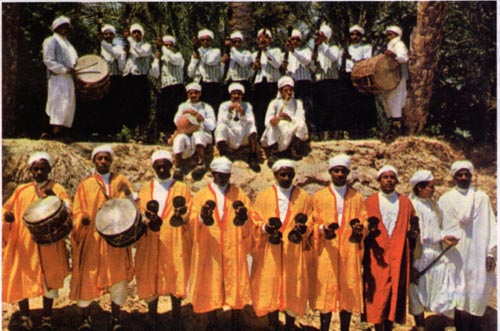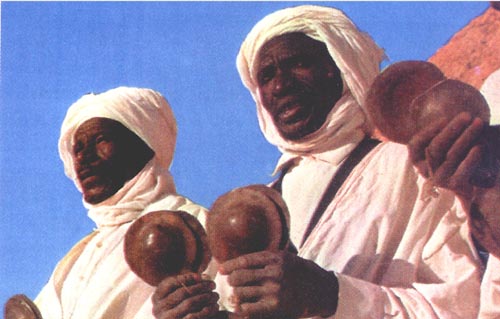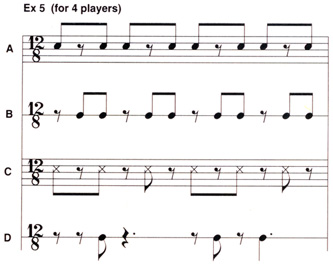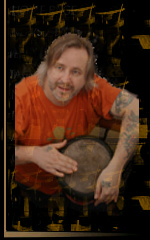Pete Lockett looks at the Rhythms of the
Mahgreb and how to clap properly
Most people have quite a vague idea of the specifics of African
drumming. If you were asked what the distinction is between North
African and Central/Southern drumming, what would you answer? Would you
group all African drumming under one umbrella? As we will see from this
article, the drumming of North Africa is very different indeed from the
rest of Africa. The Maghreb is the name given to the five Northern
African states, namely Morocco, Algeria, Tunisia, Mauritania and Libya.
(We’ll look at Egypt a little later.) The word actually means ‘sunset’
in Arabic. The sun sets in the west and therefore, for the Arabic
people, the Northern African mainland is in the west; hence, the Maghreb.
If you look at a map of Africa you will realise that there is one very
important landmark separating these North African countries from the
rest of Africa. The Sahara desert, although the perfect place for
opening up a speculative ice cream shop, is not ideal for travelling
across, camel or not.

For centuries North Africa has been
invaded by many diverse cultures. The influence these invasions has had
on the countries is enormous and is reflected in the shaping of, amongst
other things, the music and percussion. Central and Southern Africa were
not invaded in the same fashion because of the shielding and
uncompromising desert. The Berber people were the native
inhabitants of Maghreb, and the Berber language still survives today.
(For example, one fifth of the population of Algeria speak it while the
majority speak Arabic.) Before looking at the music, it is important to
realise that these countries have experienced rule from cultures as
diverse as French, Roman, Turkish, Arabic and Spanish. Phoenicians and
Carthaginians traded with Berbers but never managed to penetrate inland.
Romans found them unconquerable and gave them the name Berbers. Berbers
called themselves ‘Imazighen’, which means ‘The free men’. It is these
eclectic influences that primarily differentiate Maghreb from Africa.
The northern part of the Maghreb really is far more South Mediterranean
than it is African. Egypt is the one exception in North Africa, being so
close to Jordan, Saudi Arabia and the general Gulf that is
predominantly Middle Eastern and Oriental. The southern part, however,
is far more African. West African influence is very strong,
particularly in the south.
It is often thought that Andalucian music necessarily includes Flamenco.
This overlooks the fact that a form of Andalucian music exists in
Maghreb. In 711 Spain was invaded by Berbers and Arabs who stayed there
until 1492. This period was known as Andalucian Spain. The Arabs of
Spain, with influences from Baghdad, Iraq, formulated the beginnings of
Andalucsan music. During the Fourteenth Century the Andalucian Muslim
and Jewish population were thrown out of Spain and returned to North
Africa. This music then became the classical music of Maghreb, and is
the style of music in which one is most likely to find odd timings. The
construction of the odd timings is not repetitive like in a lot of East
European and Middle Eastern music, but presents itself in the
juxtaposition of odd and even length bars.

Running alongside this we also get the
folkloric tradition, utilising the more common 4/4, 6/8 and 12/8
timings. Simple as this may sound, it is anything but. The rhythms are
actually extremely difficult because of their elusive off-beat placement
of strategic notes in the bar. The most common misconception is to hear
it backwards or in the wrong place. For example, check ex 1 and 2 for
the basic four and six beat rhythmic frameworks (called chaabi, simply
translating into ‘popular music’ in Arabic). Notice how the bass note is
on beat four in the four beat version. Also notice how the six beat
rhythm resembles the four beat in its general shape. This framework
could be compared to the two basic Afro-Cuban structures of Martillo
(for bongos) and basic Tumbao (as played on the tumba, for example, in
Rumba). The African influence is unmistakable from this comparison
alone.


Now look at Examples 3 and 4. (It is what Examples 1 and 2 would look
like if you were hearing them backwards.)


These rhythms are the basic backbone of
a lot of the drumming found in the Maghreb. The patterns are usually
built up by keeping the basic framework and decorating it with ruffs and
ornaments in the gaps (musically, not incessantly). It’s not quite as
simple as that, but one could say that it was a rough synopsis.

The drums of the Maghreb come in many
shapes and sizes, and bear a lot more resemblance to their Middle
Eastern counterparts than they do to their African. We’re going to begin
by looking at a traditional Berber instrument called the bendir. The
bendir is a frame drum made from wood and covered with animal hide. The
qualification for a frame drum is basically any drum in which the shell
is less deep than the head is wide. The wood for these drums is often
bent, usually quite thin. Inside the head of the bendir are a number of
thin strands which stretch across the inside of the head, causing a
vibration not dissimilar to a snare drum when the head is hit. For
maximum effect the head needs to be thin whilst the snares are not too
thin. Drums such as the snared bendir are rarely found anywhere else in
the Middle East because it is a traditional Berber instrument dating
centuries.
The chaabi rhythm is often played on the bendir which, like many Maghreb
percussion instruments, can be played one-handed. It is held with one
hand with the drum head angled downwards, almost facing the floor. The
basic rhythms are articulated by using a full-handed open note and a
full-handed soft slap closed note. It is only rarely that the bendir is
played on the rim, apart from some notes from the hand supporting the
drum.
Krakeb, or kakabou (metal castanets), are also essential as building
blocks of the rhythm. Heavy metal beaters shaped like double-ended
spoons are held, two in each hand, and beaten together, usually
contributing a strong semi-quaver level pulse to the groove. The Sufi
group most commonly known for using these are the Gnawa. They go around
to people’s houses on request and play music for them all night, wiith
the intention of healing and trancing them.

The darabuka is another essential
percussion instrument in the Maghreh. Traditionally made from clay,
goblet shaped and with a fish skin head. The body of the drum is fat at
the top, tapering down into a thinner cylinder for most of the length of
the shell. The drum is sometimes held between the legs but more often is
supported on the thigh and held in place by the forearm in such a way as
to allow the hand to come over the top into a position to strike.
Sometimes the drum is held on the shoulder or between the legs. It is
the first of these three positions which is most common in Maghreb. The
drums are imported from Egypt, especially the new aluminium, tuneable
variety. Anyone who has ever been present at an Algerian or North
African concert will be aware of the enthusiastic audience response of
getting involved and clapping on the beat in very much the same way as
with Qwali music from North India. An authentic clap from this part of
the world is quite astonishing, and not easy to copy. By cupping the
hands into a particular shape and striking in a particular way, you can
hear and feel the air being caught between the two striking hands. The
movement of the arms also appears quite important, being quite relaxed
and flowing. Traditionally it’s common for groups of people to get
together and start clapping. (Similar again to the Spanish tradition)
One possible juxtaposition of patterns is given in Example 5 for four
people. It is similar to the Cuban bata drum approach of Santeria, which
we must not forget also has African roots.
This rhythm is also sometimes played on small drums called tarija. The
tarija is a small clay drum shaped like a thin cylinder which splays out
at the top and has a skin at this end. It is held with the left hand,
the skin angled slightly towards the floor. It is hit with the finger of
the other hand. These ensemble drums come in slightly different sizes,
thus giving each drum in the ensemble a different pitch. Another drum
found in Algeria is the guellal, a drum made from a piece of piping with
a skin affixed at one end around the natural bulge of the pipe joint.
(Don’t forget, pipes were around as long ago as the Romans, if not
longer). There is also a snare which is affixed inside this head. This
is the original drum found in Rai music from Algeria. Rai is a youth
music dating back to the 1970s; it comes from a folk music called
wahrani or le genre oranis. Rai was a music which started to address
everyday people’s feelings and emotions through its lyrics. This was a
leap ahead from previous, largely religious lyrics Modern Rai music has
moved on to include instruments such as the drum kit (a multi-pronged,
many headed and peculiar instrument too complex to be encompassed in
this short article) and other standard Western instruments. There is one
important thing to mention about the way the rhythms — as played on the
drum kit — get turned around because of the nature of the traditional
music.
For example, let’s take a basic four beat pattern in ex 6.
Now on the kit, the Africans would play this as the basis of the groove
(ex 7)

We, with our presuppositions, could end up hearing it as this: (ex 8)

With the knowledge of this, some musicians omitted the first snare of
each bar, thus reducing the rhythm to half time but giving it a back
beat whilst retaining the natural feel of the music: (ex 9)

At the end of the day, the music is very
similar in many ways to Qwali music from North India. It is compelling
and draws you into its infectious grooves and melodies. I recommend that
you go and listen to some. Here are a few CDs to get you started:
Cheikha Remitti, LesRacinesDn Rai (Rai Roots 929742 DK 061)
Bellemou Messaoud, Le Pere Du Red (WC DOll)
Khaled, N’SSIN’SSI(519898-2 900)
Houria Aichi, Songs 0/The Aures (Audidis Distribution B6749)
Tabours Du Maroc, Drums 0/Morocco (Aadar Al Sur)

|

